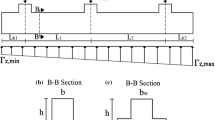Abstract
This paper is concerned with the cost minimization of prestressed concrete beams using a special differential evolution-based technique. The optimum design is posed as single-objective optimization problem in presence of constraints formulated in accordance with the current European building code. The design variables include geometrical dimensions that define the shape of the cross section and the amount of prestressing steel. A special (μ + λ)-constrained differential evolution method is performed in order to solve the optimization problem. Its search mechanism depends on several mutation strategies whereas an archiving-based adaptive tradeoff model is in charge of selecting a specific constraint-handling technique. Finally, numerical examples are included to illustrate the application of the presented approach.




Similar content being viewed by others
References
Al-Gahtani AS, Al-Saadoun SS, Abul-Feilat EA (1995) Design optimization of continuosu partially prestressed concrete beams. Comput Struct 55(2):363–370
Aydn Z, Ayvaz Y (2010) Optimum topology and shape design of prestressed concrete bridge girders using a genetic algorithm. Struct Multidiscip Optim 41(1):151–162
Barakat S, Kallas N, Taha MQ (2003) Single objective reliability-based optimization of prestressed concrete beams. Comput Struct 81(26–27):2501–2512
Barakat S, Bani-Hanib K, Taha MQ (2004) Multi-objective reliability-based optimization of prestressed concrete beams. Struct Saf 26(3):311–342
Chuanwen J, Bompard E (2005) A hybrid method of chaotic particle swarm optimization and linear interior for reactive power optimisation. Math Comput Simul 68(1):57–65
Coelho LS, Herrera BM (2007) Fuzzy identification based on a chaotic particle swarm optimization approach applied to a nonlinear Yo-yo motion system. Math Comput Simul 54(6):3234–3245
Conn AR, Gould NIM, Toint PL (1991) A globally convergent augmented Lagrangian algorithm for optimization with general constraints and simple bounds. SIAM J Numer Anal 28(2):545–572
El Semelawy M, Nassef AO, El Damatty AA (2012) Design of prestressed concrete flat slab using modern heuristic optimization techniques. Expert Syst Appl 39(5):5758–5766
European Committee for Standardisation (2004) Eurocode 2. Design of concrete structures-part 1-1: general rules and rules for buildings, EN 1992-1-1
Fiore A, Monaco P, Raffaele D (2012) Viscoelastic behaviour of non-homogeneous variable-section beams with post-poned restraints. Comput Concr 9(5):375–392
Fiore A, Foti D, Monaco P, Raffaele D, Uva G (2013) An approximate solution for the rheological behavior of non-homogeneous structures changing the structural system during the construction process. Eng Struct 46:631–642
He S, Wu QH, Wen JY, Saunders JR, Paton RC (2004) A particle swarm optimizer with passive congregation. Biosystems 78(1–3):135–147
Jia G, Wang Y, Cai Z, Jin Y (2013) An improved (μ + λ)-constrained differential evolution for constrained optimization. Inf Sci 222(0):302–322
Marano GC, Quaranta G, Monti G (2011) Modified genetic algorithm for the dynamic identification of structural systems using incomplete measurements. Comput Aided Civ Infrastruct Eng 26(2):92–110
Marano GC, Quaranta G, Avakian J, Palmeri A (2013) Identification of passive devices for vibration control by evolutionary algorithms. In: Gandomi AH, Yang X, Talatahari S, Alavi A (eds) Metaheuristic application in structures and infrastructures. Elsevier
Martí JV, González-Vidosa F (2010) Design of prestressed concrete precast pedestrian bridges by heuristic optimization. Adv Eng Softw 41(7–8):916–922
Monti G, Quaranta G, Marano GC (2010) Genetic-algorithm-based strategies for dynamic identification of nonlinear systems with noise corrupted response. ASCE J Comput Civ Eng 24(2):173–187
Ohkubo S, Dissanayake PBR, Taniwaki K (1998) An approach to multicriteria fuzzy optimization of a prestressed concrete bridge system considering cost and aesthetic feeling. Struct Optim 15(2):132–140
Quaranta G, Monti G, Marano GC (2010) Parameters identification of Van der Pol-Duffing oscillators via particle swarm optimization and differential evolution. Mech Syst Signal Process 24(7):2076–2095
Quaranta G, Avakian J, Marano GC, Monti G (2011) Numerical and experimental assessment of various non-classical methods for parametric identification of nonlinear viscous dampers. In: Proceedings of the 3rd international conference on computational methods in structural dynamics and earthquake engineering (COMPDYN 2011), Corfu
Author information
Authors and Affiliations
Corresponding author
Rights and permissions
About this article
Cite this article
Quaranta, G., Fiore, A. & Marano, G.C. Optimum design of prestressed concrete beams using constrained differential evolution algorithm. Struct Multidisc Optim 49, 441–453 (2014). https://doi.org/10.1007/s00158-013-0979-5
Received:
Revised:
Accepted:
Published:
Issue Date:
DOI: https://doi.org/10.1007/s00158-013-0979-5




